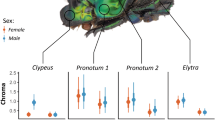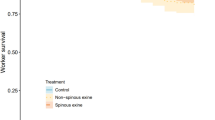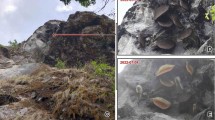Abstract
Myrmecophilus crickets are well-known inquilines that live and obtain food resources in ant nests. In Japanese Myrmecophilus species various degrees of host specificity are reflected in behavioral differences among species. For example, extremely specialized species perform trophallaxis with their host ant species, whereas generalist species may steal food from their hosts without any intimate contact. We examined behavioral variations among four Myrmecophilus species that use different hosts and show different degrees of specificity, and we also compared morphological traits such as mandible shape and hind leg length among the species. The morphometric analyses showed that an extreme host-specialist species had less complex and largely non-functional mandibles, reflecting its dependence on trophallaxis with its host ant species. In contrast, extreme host-generalist and/or moderate specialist species, which directly eat solid foods, had more complex and functional mandibles which they use to cut and crush their foods, such as insect carcasses and ant larvae. The extreme host-specialist species had shorter hind legs than the extreme host-generalist. This may reflect that it suffers few attacks from the host ants. Our results show that in Myrmecophilus food sources shape behavioral interactions with host ant species and correlate with morphological characteristics.



Similar content being viewed by others
References
Akino T, Mochizuki R, Morimoto M, Yamaoka R (1996) Chemical camouflage of myrmecophilous cricket Myrmecophilus sp. to be integrated with several ant species. Jpn J Appl Entomol Zool 40:39–46
Als TD, Vila R, Kandul NP, Nash DR, Yen SH, Mignault AA, Boomsma JJ, Pierce NE (2004) The evolution of alternative parasitic life histories in large blue butterflies. Nature 432:386–390
Baccetti B (1967) Notulae orthopterologicae XXII. II Genere Myrmecophilus Berth. in Italia. Redia 50:1–33
Bennet-Clark HC (1990) Jumping in orthoptera. In: Chapman RF, Joern A (eds) Biology of grasshoppers. Wiley-Interscience, New York, pp 173–203
Bernard F (1968) Les fourmis (Hymenoptera Formicidae) d`Europe occidentale et septentrionale. Faune d’Europe et du Bassin Méditerranéen 3. Masson, Paris
Blanckenhorn WU, Kraushaar URS, Teuschl Y, Reim C (2004) Sexual selection on morphological and physiological traits and fluctuating asymmetry in the black scavenger fly Sepsis cynipsea. J Evol Biol 17:629–641
Brues CT (1939) Food, drink, and evolution. Science 90:145–149
Burrows M, Picker MD (2010) Jumping mechanisms and performance of pygmy mole crickets (Orthoptera, Tridactylidae). J Exp Biol 213:2386–2398
Chapman RF (1964) The structure and wear of the mandibles in some African grasshoppers. J Zool 142:107–122
Chapman RF (1995) Mechanics of food handing by chewing insects. In: Chapman RF, Gerrit de B (eds) Regulatory mechanisms in insect feeding. Springer, Berlin, pp 3–31
De Boer G (1995) Introduction. In: Chapman RF, Gerrit de B (eds) Regulatory mechanisms in insect feeding. Springer, Berlin, p 19
Donovan SE, Jones DT, Sands WA, Eggleton P (2000) Morphological phylogenetics of termites (Isoptera). Biol J Linn Soc 70:467–513
El Ela SA, El Sayed W, Nakamura K (2010) Mandibular structure, gut contents analysis and feeding group of orthopteran species collected from different habitats of Satoyama area within Kanazawa City, Japan. J Threat Taxa 2:849–857
Fiedler K (1990) Effects of larval diet on myrmecophilous qualities of Polyommatus icarus caterpillars (Lepidoptera: Lycaenidae). Oecologia 83:284–287
Fiedler K (2006) Ant-associates of Palaearctic lycaenid butterfly larvae (Hymenoptera: Formicidae; Lepidoptera: Lycaenidae): a review. Myrmecol Nachricht 9:77–87
Gangwere SK (1965) Food selection in the Oediponidae grasshopper Arphia sulphurea. Am Midl Nat 74:67–75
Gangwere SK, Spiller DO (1995) Food selection and feeding behavior in selected Orthoptera sen. lat. of the Balearic Islands, Spain. J Orthopt Res 4:147–160
Gapud VP (1968) The external morphology of the head and mouthparts of some Philippine Orthoptera. Philippine Entomol 1:11–32
Gilchrist AS, Partridge L (2001) The contrasting genetic architecture of wing size and shape in Drosophila melanogaster. Heredity 86:144–152
Henderson G, Akre RD (1986) Biology of the myrmecophilous cricket, Myrmecophila manni., (Orthoptera: Gryllidae). J Kans Entomol Soc 59:454–467
Hölldobler B (1985) Liquid food transmission and antennation signals in ponerine ants. Isr J Entomol 19:89–99
Hölldobler K (1947) Studien über die Ameisengrille (Myrmecophila acervorum Panzer) im mittleren Maingebiet. Mitt Schweiz Ent Ges 20:607–648
Ingrisch S (1995) Eine neue Ameisengrille aus Borneo (Ensifera: Grylloidea). Entomol Z 105:421–440
Isley FB (1944) Correlation between mandibular morphology and food specificity in grasshoppers. Ann Entomol Soc Am 37:47–67
Javier R, Xim C (1994) Agonistic relationships among sympatric Mediterranean ant species (Hymenoptera: Formicidae). J Insect Behav 8:365–380
Judge KA, Bonanno VL (2008) Male weaponry in a fighting cricket. Plos One 3:e3980. doi:10.1371/journal.pone.0003980
Kang L, Gan Y, Li SL (1999) The structural adaptation of mandibles and food specificity in grasshoppers on Inner Mongolian grasslands. J Orthopt Res 8:257–269
Kaufmann T (1965) Biological studies on some Bavarian Acridoidea (Orthoptera), with special reference to their feeding habits. Ann Entomol Soc Am 58:791–801
Kistner DH (1979) Social and evolutionary significance of social insects symbionts. In: Hermann HR (ed) Social insects, vol I. Academic Press, New York, pp 339–413
Kistner DH (1982) The social insects’ bestiary. In: Hermann HR (ed) Social insects, vol III. Academic Press, New York, pp 1–244
Komatsu T (2013) Myrmecophilus kubotai Maruyama 2004. In: Maruyama M, Komatsu T, Kudo S, Shimada T, Kinomura K (eds) The guests of Japanese ants. Tokai University Press, Kanagawa, p. 208
Komatsu T (2014) Discoveries in field work no.14. Strange-man of the mountain behind; naturalist wondering in the field. Tokai University Press, Kanagawa, p. 276
Komatsu T, Maruyama M, Ueda S, Itino T (2008) mtDNA phylogeny of Japanese ant crickets (Orthoptera: Myrmecophilidae): diversification in host specificity and habitat use. Sociobiology 52:553–565
Komatsu T, Maruyama M, Itino T (2009) Behavioral difference between two ant cricket species in Nansei Islands: host-specialist versus host-generalist. Insect Soc 56:389–396
Komatsu T, Maruyama M, Itino T (2010) Difference in host specificity and behavior of two ant cricket species (Orthoptera: Myrmecophilidae) in Honshu, Japan. J Entomol Sci 45:227–238
Komatsu T, Maruyama M, Itino T (2013) Nonintegrated host association of Myrmecophilus tetramorii, a specialist myrmecophilous ant cricket. Psyche 2013:568536. doi:10.1155/2013/568536
Konuma J, Nagata N, Sota T (2011) Factors determining the direction of ecological specialization in snail-feeding carabid beetles. Evol Int J org Evol 65:408–418
Koshikawa S, Matsumoto T, Miura T (2002) Morphometric changes during soldier differentiation of the damp-wood termite Hodotermopsis japonica (Isoptera, Termopsidae). Insect Soc 49:245–250
Kozarzhevskaya E (1986) Scale insects (Homoptera, Coccoidea) of ornamental plants in the European part of the USSR and some neighboring countries. Entomol Rev 64:144–158
Krenn HW (2010) Feeding mechanisms of adult Lepidoptera: structure, function, and evolution of the mouthparts. Annu Rev Entomol 55:307–327
Lach L (2003) Invasive ants: unwanted partners in ant-plant interactions? Ann Mo Bot Gard 90:91–108
Liebermann J (1968) The mandibles of grasshoppers of the subfamily Chilacridinae. Rev Invest Agropecu 5:53–62 (Spanish)
Maruyama M (2004) Four new species of Myrmecophilus (Orthoptera. Myrmecophilidae) from Japan. Bull Nat Sci Mus 30:37–44
Maruyama M (2006) Family Myrmecophilidae Saussure, 1870. In: Orthopterological Society of Japan (ed) Orthoptera of the Japanese archipelago in color, Hokkaido University Press, Sapporo, p. 687
McCollum SA, Leimberger JD (1997) Predator-induced morphological changes in an amphibian: predation by dragonflies affects tadpole shape and color. Oecologia 109:615–621
Mulkern GB (1967) Food selection by grasshoppers. Annu Rev Entomol 12:59–78
Neoh KB, Lee CY (2009) Developmental stages and castes of two sympatric subterranean termites Macrotermes gilvus and Macrotermes carbonarius (Blattodea: Termitidae). Ann Entomol Soc Am 102:1091–1098
Okada Y, Plateaux L, Peeters C (2013) Morphological variability of intercastes in the ant Temnothorax nylanderi: pattern of trait expression and modularity. Insect Soc 60:319–328
Pakkasmaa S, Merilä J, O’Hara RB (2003) Genetic and maternal effect influences on viability of common frog tadpoles under different environmental conditions. Heredity 91:117–124
Patterson BD (1984) Correlation between mandibular morphology and specific diet of some desert grassland Acrididae (Orthoptera). Am Midl Nat 111:296–303
Pierce NE (1995) Predatory and parasitic Lepidoptera: carnivores living on plants. J Lepidopterists’ Soc 49:412–453
Reimer N, Beardsley JW, Jahn G (1990) Pest ants in the Hawaiian Islands. In: Vander Meer RK, Jaffe K, Cedeno A (eds) Applied myrmecology: a world host specificity and behavior of two ant crickets perspective. Westview Press, Boulder, pp 40–50
Sakai H, Terayama M (1995) Host records and some ecological information of the ant cricket Myrmecophilus sapporensis Matsumura. Ari 19:2–5 (Japanese)
Santer RD, Yamawaki Y, Rind FC, Simmons PJ (2008) Preparing for escape: an examination of the role of the DCMD neuron in locust escape jumps. J Comp Physiol A 194:69–77
Savi P (1819) Osservazioni sopra la Blatta acervorum di Panzer. Gryllus myrmecophilus. Bibl Ital 25:217–229
Schimmer F (1909) Beitrag zu einer Monographie der Gryllodeengattung Myrmecophila Latr. Ztschr Zool 93:409–534
Sutton GP, Burrows M (2008) The mechanics of elevation control in locust jumping. J Comp Physiol A 194:557–563
Tsuchiya M, Watanabe D, Maekawa K (2008) Effect on mandibular length of juvenile hormones and regulation of soldier differentiation in the termite Reticutiterme ssperatus (Isoptera: Rhinotermitidae). Appl Entomol Zool 43:307–314
Veenakumari K, Mohanrai P, Sreekumar PV (1997) Host plant utilization by butterfly larvae in the Andaman and Nicobar Islands (Indian Ocean). J Insect Conserv 1:235–246
Wheeler WM (1900) The habits of Myrmecophila nebrascensis Bruner. Psyche 9:111–115
Wheeler WM (1910) Ants: their structure, development, and behavior. Columbia University Press, New York
Wheeler WM (1928) The social insects: their origin and evolution. Kegan Paul, Trench, Trubner and Co., Ltd, London
Windig JJ, Rintamäki PT, Cassel A, Nylin S (2000) How useful is fluctuating asymmetry in conservation biology: asymmetry in rare and abundant Coenonympha butterflies. J Insect Conservn 4:253–261
Yamaguchi S (1988) The life history of five myrmecophilous lycaenid butterflies of Japan. Kodansha, Tokyo (Japanese)
Acknowledgements
We thank S. Inada, F. Ito, M. Sugimoto, and Y. Tsuneoka for providing samples. This work was supported by Japan Society for the Promotion of Science KAKENHI Grant number 14J00931 to T.K.
Author information
Authors and Affiliations
Corresponding author
Rights and permissions
About this article
Cite this article
Komatsu, T., Maruyama, M., Hattori, M. et al. Morphological characteristics reflect food sources and degree of host ant specificity in four Myrmecophilus crickets. Insect. Soc. 65, 47–57 (2018). https://doi.org/10.1007/s00040-017-0586-3
Received:
Revised:
Accepted:
Published:
Issue Date:
DOI: https://doi.org/10.1007/s00040-017-0586-3




